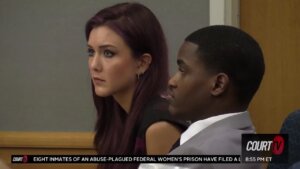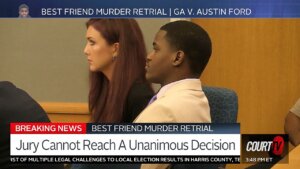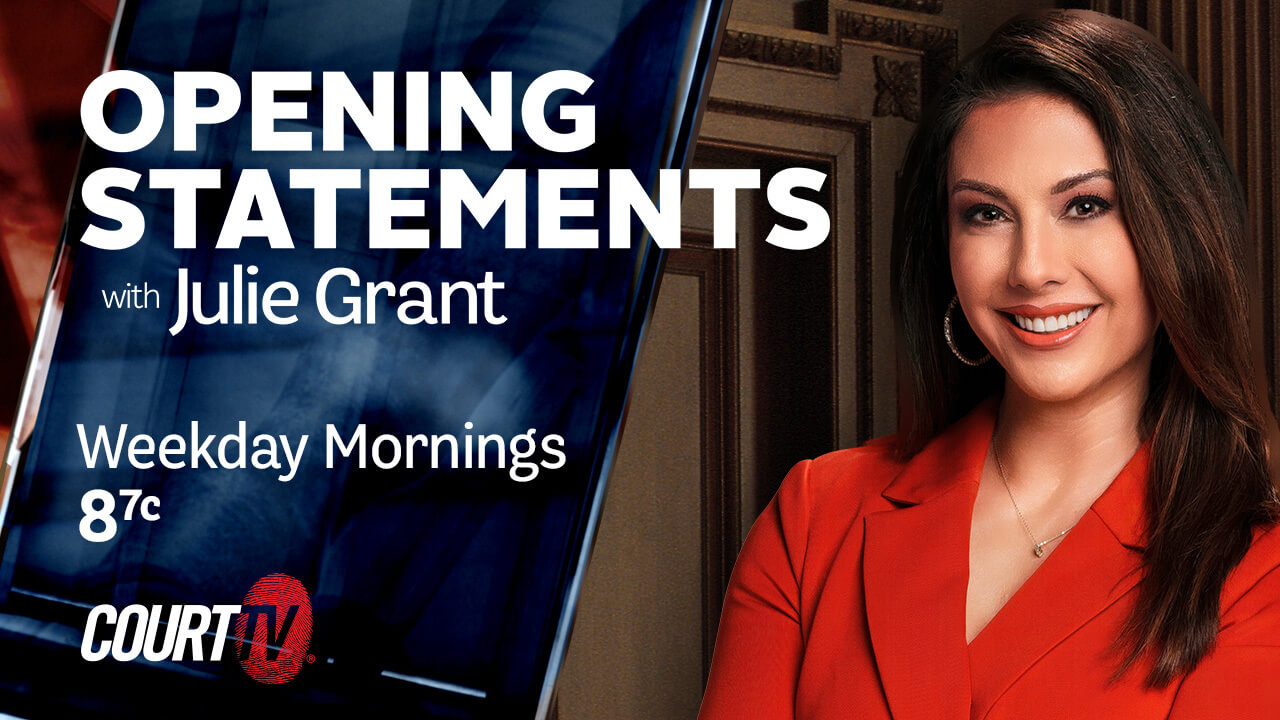GWINNETT COUNTY, Ga. (Court TV) – A Georgia jury reached a partial verdict in the murder trial of a young man accused of killing his best friend.
The court declared a mistrial on counts 1-5. Those were the most serious charges, which included felony murder. Austin Ford was found guilty on counts 6-8: theft by taking (firearm), theft by taking (vehicle), and concealing death of another (Tori Lang).
Austin Ford, 21 had faced a life sentence if convicted of felony murder for 18-year-old Tori Lang’s shooting death in July 2021.
The 12-person Gwinnett County jury announced on Monday — the third day of deliberations — that they were deadlocked. The jury indicated on Friday that they were struggling to reach a decision, saying they were “split down the middle” on the top counts of felony murder and aggravated assault and two counts of weapon possession.
Judge Deborah Fluke declared a mistrial because of the deadlock. It will be up to Gwinnett County prosecutors to decide whether to retry Ford.
Ford’s defense argued that he was wrongly accused of murder for Lang’s decision to kill herself. A medical examiner was unable to determine if Lang’s death was a homicide or suicide, but Gwinnett County prosecutors said the more likely scenario was that Ford was pointing the .9 mm handgun at Lang when the gunshot was fired.
Murder or suicide?
The mistrial on counts 1-5 brought a dramatic close to a week-long trial that offered three potential scenarios for Lang’s death: murder, suicide, or assisted suicide.
The jury heard from 14 state witnesses, including the medical examiner who was unable to determine manner of death.
Lang’s body was found under a tree in a Stone Mountain park on July 28, 2021. She was lying on her back with her long, braided hair splayed out around her head.
Dr. Carol Terry testified that Lang died from a single gunshot to the right temple that went straight across her head and severed her brain stem. Terry said ballistics evidence around the wound suggested the gun was fired from 10 to 12 inches away, and blood flow patterns indicated Lang was lying on her back when she was shot. Dr. Terry said she could not rule out the possibility of a self-inflicted gunshot wound, but said it would be difficult for Lang to shoot herself from such an angle, leaving the manner of death undetermined.
Ford’s defense learned heavily into the unknowns to raise reasonable doubt and support Ford’s claim that he didn’t want his friend to die.
Prosecutor Norris Lewis told the jury it was hard to know for certain what happened in the park given the mysterious circumstances of Lang’s death.
Nevertheless, Lewis said the evidence was clear that Ford was at the park with Lang and had a hand in her death.
“There is no evidence that there is any malice in the heart of the defendant at the time when he pulls that trigger,” the prosecutor said in his opening statement. “But I can tell you based on his actions, based on his coverup, based on his lies, he was definitely involved in pulling that trigger.”
In the state closing argument, the prosecutor used a dummy and a prop gun to describe how Lang would have had to “contort” her right hand and fire with her thumb in order to pull the trigger on herself, likening the possibility of the scenario to being struck by lightning while riding a unicorn and winning the lottery.
Conflicting statements
The jury also heard from investigators who tracked Ford’s conflicting accounts between Lang’s death and Ford’s arrest in June 2022.
Ford initially told investigators in 2021 that he last saw a distraught Lang the night of her death. He said she showed up at his apartment begging him to kill her, saying she would find someone else if he didn’t accede to her demand. Doorbell camera showed Ford and Lang leave his apartment together around 10:45 p.m., but Ford insisted he did not to go to the park with Lang.
Months later, in a March 2022 recorded police interview, Ford changed his story after investigators confronted him with cell phone and Gmail records placing him near the park around 11:05 p.m. that night, after he was seen on the doorbell camera.
Worried what she would do after seeing a gun in her car, Ford said he rode with Lang in her car to the park.
Ford said he tried to talk Lang out of harming herself. At the park, he said he wrestled the gun from her and placed it on the ground. As he tried to hug Lang, Ford said she grabbed the gun and shot herself, falling to the ground.
After the shooting, Ford said he panicked, grabbed the gun, and fled in Lang’s car as she’d told him to do on their ride to the park. The Nissan Versa was found two miles away in a nature preserve, burnt beyond recognition. Ford said he left the car there but did not torch it and had no idea what happened to it. He was charged with two counts of theft for allegedly removing them from the scene.
Multiple legal theories
Ford’s lawyer accused prosecutors of charging Ford under multiple theories because they didn’t know what happened.
Ford was charged with felony murder for allegedly causing Lang’s death while committing another crime – in this case, aggravated assault for allegedly pointing a gun at her. He was also charged with manslaughter for causing her death as the result of a “sudden, violent and irresistible passion.” In addition to the two theft counts, he was charged with counts of two weapon possession and one count of concealing information in her death.
Ford chose not to testify. His defense did not put on a case, relying instead on his lawyer’s questioning of state witnesses and the defendant’s statements to support their arguments that Ford was not responsible for Lang’s death.
Ford’s defense accused the state of scapegoating Ford for Lang’s decision to end her life because they wanted “someone to blame.” He argued that Lang had fallen prey to the pressures of social media, which drove her to depression and suicidal thoughts that were exacerbated by COVID isolation.
“Somehow, it’s Austin Ford’s fault that he didn’t do enough,” Ford’s attorney said in his closing argument. “Austin is not the reason the suicide rate is going up… It’s not Austin’s fault that people have anxiety on social media. But we’ve got to have someone to blame for Tori being there.”
TRIAL HIGHLIGHTS
DAY 4 – 4/28/23
- Jurors deliberated from 9-4:30 p.m., but were unable to come to a verdict.
- The jury sent back a note asking to review witness transcripts and to review the Ring doorbell camera video from Austin Ford’s neighbor.
- The judge denied the jury’s request for witness transcripts and allowed them to view the Ring video together.
- WATCH: Best Friend Murder Trial: Jury Asks to View Ring Footage and Witness Transcripts
- The jury sent a note to the judge saying that they were split on counts 1, 2, 4 and 5.
- The judge told the jurors to keep deliberating.
- Juror number three sent a note to the judge expressing concern over his personal bias and how that would impact his ability to deliver a verdict.
- The judge instructed the juror to continue deliberations.
- WATCH: Best Friend Murder Trial: Juror Raises Concerns About Bias
DAY 3 – 4/27/23
- Detective Angela Carter resumed her testimony, and the jury saw her recorded interview with Austin Ford.
- In the interview, Ford said Lang shot herself after he had initially gotten the gun away from her and put it on the ground.
- Ford told the detective that he did not touch Lang after the shooting.
- Ford said Lang told him to get rid of the car and the gun.
- WATCH: Best Friend Murder Trial: Day 3
- The state rested its case-in-chief.
- The defense rested without putting on a case, and the state offered no rebuttal case.
- Defendant Austin Ford did not testify.
- Both sides delivered closing arguments
- The jury began its deliberations shortly before 3 p.m. and sent two questions back to the courtroom.
- The jury asked whether it could see the prop gun and dummy used by the prosecution in its closing argument, but was told that because those items were not entered into evidence they could not examine them.
- The jury asked for the measurements of the .9mm handgun used to kill Lang, but was told that any information used in deliberation needs to come from the testimony given.
- WATCH: Best Friend Murder Trial: Jury Questions During Deliberations
DAY 2 – 4/26/23
- Gwinnett County Chief Medical Examiner Dr. Carol Terry testified that she could not definitively determine whether Tori Lang died by suicide or homicide
- WATCH: Medical Examiner Testifies in Best Friend Murder Trial
- Terry said the gunshot was fired from 10 to 12 inches away, making it unlikely – but possible – Lang shot herself.
- The jury saw body camera video and crime scene videos showing Lang’s body when it was discovered on July 28, 2021, showing her lying face up, on her back.
- Recorded police interviews were played for the jury, where Austin Ford tells police that Lang showed up at his home the night she was last seen alive asking for him to kill her.
- Detective Angela Carter testified that cellphone and Gmail records belonging to Ford contradict his timeline and put him near the park where Lang’s body was found.
- Doorbell videos from Ford’s neighbor’s apartment show Lng arriving at Ford’s apartment on July 27, 2021, the day she was last seen alive.
- The video shows Ford asking her what’s wrong and saying, “You’re scaring me.”
- The video shows Lang and Ford leaving together.
- The next video shows Ford leaving his home again after midnight.
- Ford declined to testify in his own defense, but reserved the right to change his mind after the state rests its case.
- In an unusual exchange, Ford’s attorney addressed him directly in court and explained the ramifications of the decision not to testify. The jury was not present.
DAY 1 – 4/25/23
- Both sides deliver opening statements offering three theories of Tori Lang’s death: suicide, assisted suicide or murder?
- Prosecutor Norris Lewis said it didn’t matter which was true because Austin Ford admitted to being involved in all of them, whereas defense lawyer Lawrence Lewis said the conflicting theories gave rise to reasonable doubt.
- The victim’s mother, Teresa Lang, teared up recalling the search for her daughter and the discovery of her body.
- Teresa Lang testified that Ford initially denied seeing her daughter the night Tori Lang was last seen alive, then later claimed that she showed up at Ford’s home looking for someone “to hurt her for $300.”
- When asked on cross if Tori Lang experienced suicidal ideation, Teresa Lang said her daughter was hospitalized in high school for an “incident” but did not receive any mental health diagnoses.
- The victim’s grandmother, Tanya Lang, testified that her name was on the title and registration for the Nissan Versa that her granddaughter drove.
- Ford is charged with theft for removing the car from the park where Tori Lang was found dead. Tanya Lang testified that she never gave Ford permission to use the vehicle.
- A police officer described the discovery of a burnt vehicle matching the description of Tori Lang’s Nissan in a wooded nature preserve. Under questioning from Ford’s defense, Jonathan Santamaria said he could not positively identify the car as Lang’s due to its condition.
- Fire investigator Jason Stribling said the car was most likely set on fire from the inside in the same spot it was found.
















